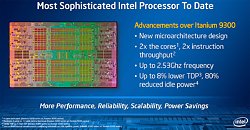- Joined
- Oct 9, 2007
- Messages
- 47,233 (7.55/day)
- Location
- Hyderabad, India
| System Name | RBMK-1000 |
|---|---|
| Processor | AMD Ryzen 7 5700G |
| Motherboard | ASUS ROG Strix B450-E Gaming |
| Cooling | DeepCool Gammax L240 V2 |
| Memory | 2x 8GB G.Skill Sniper X |
| Video Card(s) | Palit GeForce RTX 2080 SUPER GameRock |
| Storage | Western Digital Black NVMe 512GB |
| Display(s) | BenQ 1440p 60 Hz 27-inch |
| Case | Corsair Carbide 100R |
| Audio Device(s) | ASUS SupremeFX S1220A |
| Power Supply | Cooler Master MWE Gold 650W |
| Mouse | ASUS ROG Strix Impact |
| Keyboard | Gamdias Hermes E2 |
| Software | Windows 11 Pro |
Intel has unceremoniously, through a product change notification (PCN), discontinued the Itanium family of microprocessors. The Itanium 9700 "Kittson," which was released in 2017, is the final generation of Itanium, and its sales to new customers have stopped according to the PCN. The series has been marked "end of life" (EOL). Existing customers of Itanium who already have their IT infrastructure built around Itanium 9700 series, have an opportunity to determine their remaining demand of these processors, and place their "Last Product Discontinuance" order with Intel. The final LPD shipments would go out mid-2021.
With this move, Intel has cast uncertainty over the future of the IA-64 microarchitecture. IA-64 was originally conceived by Intel to replace 32-bit x86 at the turn of the century, as an industry-standard 64-bit processor architecture. AMD laid the foundation for its rival standard AMD64, which could go on to become x86-64. AMD64 won the battle for popularity over IA-64, as it maintained complete backwards-compatibility with x86, and could seamlessly run 32-bit software, saving enterprises and clients billions in transition costs. Intel cross-licensed it as EM64T (extended memory 64-bit technology), before standardizing the name x86-64. Itanium dragged on for close to two decades serving certain enterprise and HPC customers.

View at TechPowerUp Main Site
With this move, Intel has cast uncertainty over the future of the IA-64 microarchitecture. IA-64 was originally conceived by Intel to replace 32-bit x86 at the turn of the century, as an industry-standard 64-bit processor architecture. AMD laid the foundation for its rival standard AMD64, which could go on to become x86-64. AMD64 won the battle for popularity over IA-64, as it maintained complete backwards-compatibility with x86, and could seamlessly run 32-bit software, saving enterprises and clients billions in transition costs. Intel cross-licensed it as EM64T (extended memory 64-bit technology), before standardizing the name x86-64. Itanium dragged on for close to two decades serving certain enterprise and HPC customers.

View at TechPowerUp Main Site




